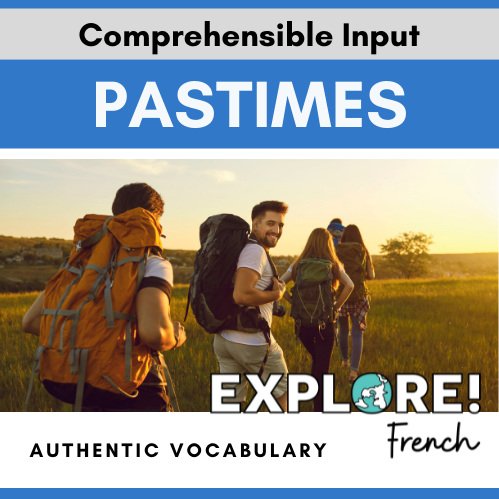Sharing the Benefits of Learning Another Language
4 ways to advocate world language instruction with students, parents, administrators, and beyond
I teach in a magnet school for world languages, and most students take a French or Spanish elective. While the program is generally popular, there are a few kids who aren’t too happy about this, and sometimes their parents aren’t either! Last week I sent home academic progress reports. When one student (who is earning a D) brought back her signed report, her mother added this note:
“My daughter is not a French student.”
I’ve been thinking a lot about this. What makes one a French student? Is it simply being enrolled in a French class? Or is it something more than this: a choice, or a decision to embrace the challenge of learning another language? Would this mom write the same thing to her daughter’s math or English teacher? “My daughter is not a math student”? This is hard to imagine.
“What makes one a French student? Is it simply being enrolled in a French class? Or is it a decision to embrace the challenge of learning another language?”
We will all encounter students, parents, and colleagues who do not share our belief in the deep benefits of learning another language. In the US, language education is in danger.
According to this 2017 study by American Councils for International Education only 20% of America’s K-12 students are enrolled in a foreign language class. This number is even lower in higher education. According to this InsideHigherEd.com article, less than 8% of university students are enrolled in a world language class, a number that has been steadily declining for 15 years. As a result, many colleges are reducing their world language departments or, in some cases, eliminating them entirely.
As language educators, it’s not enough to quietly attend to our own classrooms. We each have a role to play in promoting the value of language learning within our circles of influence.
Many researchers, bloggers, and universities have already written excellent articles listing the benefits of language learning. A quick Google search of “Why study a foreign language” will yield an abundance of results. Every language instructor needs some knowledge of the research showing cognitive, academic, and social benefits of language study. The American Council of Teachers of Foreign Languages (ACTFL) website is a great place to start; visit their website to see an excellent list of language learning benefits.
With this knowledge as a foundation, here are a few suggestions for sharing the benefits of language study with your students, parents, and administrators:
1) Teach about the language learning process.
In the US, where I teach, many families have extremely limited experience with language learning. Often parents tell me, “I took 3 years of French in high school, and the only thing I can do is ask for the bathroom.” This comment betrays a fundamental misunderstanding of the nature of learning a language; 3 years of classroom instruction is not enough to reach “fluency”, which is many learners’ goal.
The truth is, learning a language is hard! It takes years of investment and a willingness to push through awkwardness and feelings of ineptitude. By fostering realistic expectations, we can strengthen our programs and contribute to our students’ success.
Here’s a handout I created for my novice and intermediate learners, showing ACTFL’s language learning levels. For romance languages, it takes around 250 hours of study to advance to intermediate low, and another 250 hours to move on to intermediate mid. (Of course, many factors influence this number, but it’s a good rule of thumb for students, based on this University of Oregon study)
I like to discuss what we mean when we say ‘fluent’ and discuss the ability to accomplish different tasks in the language. According to the University of Oregon study linked above, about 85% of students who complete a high school fourth year language class achieve minimal / Intermediate Low proficiency. The study concludes, “If districts want to give students…professional-level skills, however, they should consider starting (world language) programs at the elementary or middle school level and adding higher level high school classes.” Colleges can build on the intermediate proficiency many students achieve by providing courses designed to build advanced-level language skills. This perspective is important for every advocate of world language instruction to know and share.
One final technique for sharing the language learning process: during parent nights, open houses, and the like, teach parents a short lesson in the target language. I like to provide parents with a simple target language infographic and ask them to figure out written vocabulary. This is achievable and fun, and it helps parents experience a little of what their children will be doing in my class. Here are links to free Authentic Vocabulary samples for French and for Spanish, which are available on my Teachers Pay Teachers store!
2) Highlight the soft-skills benefits of language learning
Eventual fluency is not the only reason to study a language. The study process alone is intrinsically valuable.
“Learning a language is hard! It takes years of investment. We can strengthen our programs by fostering realistic expectations.”
Think about it: we ask students to practice many skills they will not directly use in their ‘real’ lives. How many students go on to use mathematical functions, read Shakespeare, or balance chemical equations? So why do we require high school Pre-Calculus, English Literature, and Chemistry? As a society, we have agreed that 1) exposure to these disciplines is part of being an informed member of our populace, and 2) the challenging thought processes required to master this content is an important part of academic development.
Here’s how I explain this to my students when they ask me, “When are we ever gonna need this?” (This is my 21st year teaching, so I’ve answered this question at least 4,826,321 times)
Student: “This is stupid. Why do we have to (fill in the blank with current activity).
Me: “Last night, I was watching the football team practice. I saw the coach set 2 cones on the field, and the players had to crab-walk sideways, very fast, back and forth between the cones. Then the coach made the players run through rubber tires. It was hard. One player fell down, and I’m pretty sure they all hated it.
I’ve never seen football players crab-walk between cones during a game… so why is the coach wasting their time?
I thought, ‘That’s so stupid! I’ve been to lots of football games, and I’ve NEVER seen the players run sideways between cones during a play. I’ve NEVER seen them run through tires during a game. The coach is wasting their time!’ Why would he make them do that?”
Student: (reluctantly) “Because improving their footwork and stamina are skills they need to play well”.
Me: Right! And (insert current activity) is just the same. You may not do this exact activity later in your life. You might not even continue on with French after this class. But the academic exercise we’re doing helps condition your brain, just like the cone and tire drills help condition the football players’ bodies. That’s why colleges want you to have two years of world language classes. It’s good for you.”
“We ask students to practice many skills they will not directly use in their ‘real’ lives... the challenging though processes required to master this content is an important part of academic development.”
I love this approach because it takes the students’ concern seriously, and the answer is connected to kids’ experience. Of course you can modify the analogy for most any activity - sports, music, dance… the process of mastery is remarkably similar across disciplines.
Helping students recognize this and embrace the challenge of personal discipline for self-improvement: this is education in a nutshell, and reason enough to study French!
3) Make your classes AWESOME!
The BEST way to advocate for your program is to make sure the product you offer is one students (and their families) want. Be innovative, stay current, and teach a hands-on, communicative class. Of course, this isn’t a guarantee that your program will be supported from above, but it’s one factor we do have control over. When your class is good, word gets around, and when kids are clamoring for your classes, admin will be more likely to support your program. This is good for your students, good for you, and good for education as a whole.
My blog posts on using music in the world language classroom, Authentic Vocabulary Instruction, and ideas for teaching numbers effectively are great resources. And check the “lesson ideas” category for some of my favorite lesson ideas, which I update regularly!
4) Join a professional organization for your language
Joining a professional organization allows you to:
Access a library of professional resources and research
Become eligible for grants and scholarships
Participate in professional development for language educators
Stay informed about developments in the world of language instruction
Support language-instruction advocacy at the local, state, and national level
Develop friendship and a support network with other teachers who help you practice your language skills and generously share resources
Here links to some major organizations:
American Association of Teachers of French (AATF)
American Association of Teachers of Spanish and Portuguese (AATSP)
American Association of Teachers of German (AATG)
National Council of Less Commonly Taught Languages (NCOLCTL)
American Council of Teachers of Foreign Languages (ACTFL)
There are organizations for many other languages; please search for one that fits your situation. And a shout out to the North Carolina branch of AATF, a fantastic group of educators and friends! Here’s our website! If you’re a French teacher in North Carolina, please join us!
I keep rethinking that parent note, “My daughter is not a language student”. I’m not sure what to say to this mother. I’d like to communicate, “Your’re right, she’s not. But she COULD be! She SHOULD be! She needs adults in her life to show her the way. Learning a language is a tremendous gift. Let’s encourage your daughter to embrace her potential!”
How would you answer this mother? And, do you have a creative way to promote language instruction? Share in the comments!






